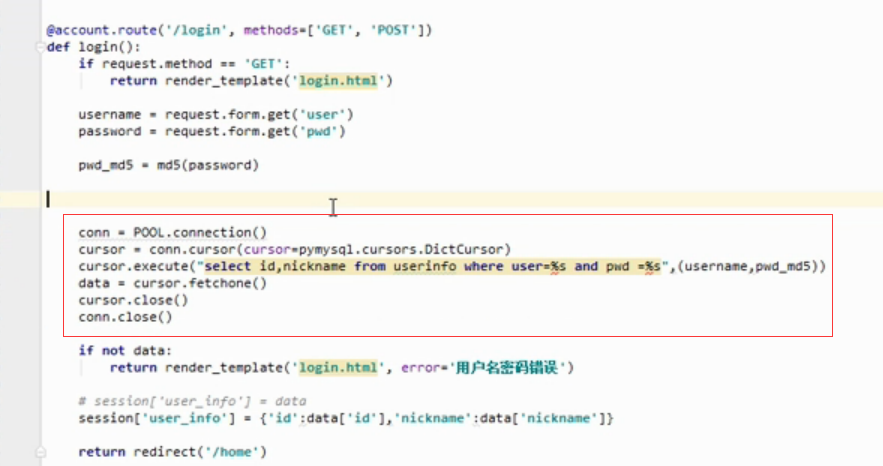DBUtils是Python的一个用于实现数据库连接池的模块。
此连接池有两种连接模式:
模式一:为每个线程创建一个连接,线程即使调用了close方法,也不会关闭,只是把连接重新放到连接池,供自己线程再次使用。当线程终止时,连接自动关闭。

POOL = PersistentDB( creator=pymysql, # 使用链接数据库的模块 maxusage=None, # 一个链接最多被重复使用的次数,None表示无限制 setsession=[], # 开始会话前执行的命令列表。如:["set datestyle to ...", "set time zone ..."] ping=0, # ping MySQL服务端,检查是否服务可用。# 如:0 = None = never, 1 = default = whenever it is requested, 2 = when a cursor is created, 4 = when a query is executed, 7 = always closeable=False, # 如果为False时, conn.close() 实际上被忽略,供下次使用,再线程关闭时,才会自动关闭链接。如果为True时, conn.close()则关闭链接,那么再次调用pool.connection时就会报错,因为已经真的关闭了连接(pool.steady_connection()可以获取一个新的链接) threadlocal=None, # 本线程独享值得对象,用于保存链接对象,如果链接对象被重置 host='127.0.0.1', port=3306, user='root', password='123', database='pooldb', charset='utf8' ) def func(): conn = POOL.connection(shareable=False) cursor = conn.cursor() cursor.execute('select * from tb1') result = cursor.fetchall() cursor.close() conn.close() func()
模式二:创建一批连接到连接池,供所有线程共享使用。
PS:由于pymysql、MySQLdb等threadsafety值为1,所以该模式连接池中的线程会被所有线程共享。

import time import pymysql import threading from DBUtils.PooledDB import PooledDB, SharedDBConnection POOL = PooledDB( creator=pymysql, # 使用链接数据库的模块 maxconnections=6, # 连接池允许的最大连接数,0和None表示不限制连接数 mincached=2, # 初始化时,链接池中至少创建的空闲的链接,0表示不创建 maxcached=5, # 链接池中最多闲置的链接,0和None不限制 maxshared=3, # 链接池中最多共享的链接数量,0和None表示全部共享。PS: 无用,因为pymysql和MySQLdb等模块的 threadsafety都为1,所有值无论设置为多少,_maxcached永远为0,所以永远是所有链接都共享。 blocking=True, # 连接池中如果没有可用连接后,是否阻塞等待。True,等待;False,不等待然后报错 maxusage=None, # 一个链接最多被重复使用的次数,None表示无限制 setsession=[], # 开始会话前执行的命令列表。如:["set datestyle to ...", "set time zone ..."] ping=0, # ping MySQL服务端,检查是否服务可用。# 如:0 = None = never, 1 = default = whenever it is requested, 2 = when a cursor is created, 4 = when a query is executed, 7 = always host='127.0.0.1', port=3306, user='root', password='123', database='pooldb', charset='utf8' ) def func(): # 检测当前正在运行连接数的是否小于最大链接数,如果不小于则:等待或报raise TooManyConnections异常 # 否则 # 则优先去初始化时创建的链接中获取链接 SteadyDBConnection。 # 然后将SteadyDBConnection对象封装到PooledDedicatedDBConnection中并返回。 # 如果最开始创建的链接没有链接,则去创建一个SteadyDBConnection对象,再封装到PooledDedicatedDBConnection中并返回。 # 一旦关闭链接后,连接就返回到连接池让后续线程继续使用。 conn = POOL.connection() # print(th, '链接被拿走了', conn1._con) # print(th, '池子里目前有', pool._idle_cache, ' ') cursor = conn.cursor() cursor.execute('select * from tb1') result = cursor.fetchall() conn.close() func()
如果没有连接池,使用pymysql来连接数据库时,单线程应用完全没有问题,但如果涉及到多线程应用那么就需要加锁,一旦加锁那么连接势必就会排队等待,当请求比较多时,性能就会降低了。

#!/usr/bin/env python # -*- coding:utf-8 -*- import pymysql import threading from threading import RLock LOCK = RLock() CONN = pymysql.connect(host='127.0.0.1', port=3306, user='root', password='123', database='pooldb', charset='utf8') def task(arg): with LOCK: cursor = CONN.cursor() cursor.execute('select * from tb1') result = cursor.fetchall() cursor.close() print(result) for i in range(10): t = threading.Thread(target=task, args=(i,)) t.start() 加锁

#!/usr/bin/env python # -*- coding:utf-8 -*- import pymysql import threading CONN = pymysql.connect(host='127.0.0.1', port=3306, user='root', password='123', database='pooldb', charset='utf8') def task(arg): cursor = CONN.cursor() cursor.execute('select * from tb1') result = cursor.fetchall() cursor.close() print(result) for i in range(10): t = threading.Thread(target=task, args=(i,)) t.start() 无锁(报错)
Flask中使用DBUtils

from DBUtils.PooledDB import PooledDB, SharedDBConnection import pymysql class Config(object): SALT = b"sdf1123df" SECRET_KEY = 'asdf123sdfsdfsdf' MAX_CONTENT_LENGTH = 1024 * 1024 * 7 POOL = PooledDB( creator=pymysql, # 使用链接数据库的模块 maxconnections=6, # 连接池允许的最大连接数,0和None表示不限制连接数 mincached=2, # 初始化时,链接池中至少创建的空闲的链接,0表示不创建 maxcached=5, # 链接池中最多闲置的链接,0和None不限制 maxshared=3, # 链接池中最多共享的链接数量,0和None表示全部共享。PS: 无用,因为pymysql和MySQLdb等模块的 threadsafety都为1,所有值无论设置为多少,_maxcached永远为0,所以永远是所有链接都共享。 blocking=True, # 连接池中如果没有可用连接后,是否阻塞等待。True,等待;False,不等待然后报错 maxusage=None, # 一个链接最多被重复使用的次数,None表示无限制 setsession=[], # 开始会话前执行的命令列表。如:["set datestyle to ...", "set time zone ..."] ping=0, # ping MySQL服务端,检查是否服务可用。# 如:0 = None = never, 1 = default = whenever it is requested, 2 = when a cursor is created, 4 = when a query is executed, 7 = always host='127.0.0.1', port=3306, user='root', password='123456', database='s9day118', charset='utf8' )
view中
from settings import Config

Flask中使用DBUtils 简化版


import pymysql from settings import Config def connect(): conn = Config.POOL.connection() cursor = conn.cursor(cursor=pymysql.cursors.DictCursor) return conn,cursor def connect_close(conn,cursor): cursor.close() conn.close() def fetch_all(sql,args): conn,cursor = connect() record_list = cursor.execute(sql, args) # record_list = cursor.fetchall() connect_close(conn,cursor) return record_list def fetch_one(sql, args): conn, cursor = connect() cursor.execute(sql, args) result = cursor.fetchone() connect_close(conn, cursor) return result def insert(sql, args): conn, cursor = connect() row = cursor.execute(sql, args) conn.commit() connect_close(conn, cursor) return row

from DBUtils.PooledDB import PooledDB, SharedDBConnection import pymysql # 下载 DBUtils : pip3 install DBUtils class Config(object): SALT = b"sdf1123df" SECRET_KEY = 'asdf123sdfsdfsdf' MAX_CONTENT_LENGTH = 1024 * 1024 * 7 POOL = PooledDB( creator=pymysql, # 使用链接数据库的模块 maxconnections=6, # 连接池允许的最大连接数,0和None表示不限制连接数 mincached=2, # 初始化时,链接池中至少创建的空闲的链接,0表示不创建 maxcached=5, # 链接池中最多闲置的链接,0和None不限制 maxshared=3, # 链接池中最多共享的链接数量,0和None表示全部共享。PS: 无用,因为pymysql和MySQLdb等模块的 threadsafety都为1,所有值无论设置为多少,_maxcached永远为0,所以永远是所有链接都共享。 blocking=True, # 连接池中如果没有可用连接后,是否阻塞等待。True,等待;False,不等待然后报错 maxusage=None, # 一个链接最多被重复使用的次数,None表示无限制 setsession=[], # 开始会话前执行的命令列表。如:["set datestyle to ...", "set time zone ..."] ping=0, # ping MySQL服务端,检查是否服务可用。# 如:0 = None = never, 1 = default = whenever it is requested, 2 = when a cursor is created, 4 = when a query is executed, 7 = always host='127.0.0.1', port=3306, user='root', password='123456', database='db2', charset='utf8' )

@account.route('/login/', methods=['GET', 'POST']) def login(): ''' 登陆 :return: ''' if request.method == 'GET': return render_template('login.html') username = request.form.get('user') password = request.form.get('pwd') pwd_md5 = md5(password) data = helper.fetch_one("select id,nickname from userinfo where user=%s and pwd =%s", (username, pwd_md5)) if not data: return render_template('login.html', error='用户名密码错误') # session['user_info'] = data session['user_info'] = {'id': data['id'], 'nickname': data['nickname']} return redirect('/home/')
